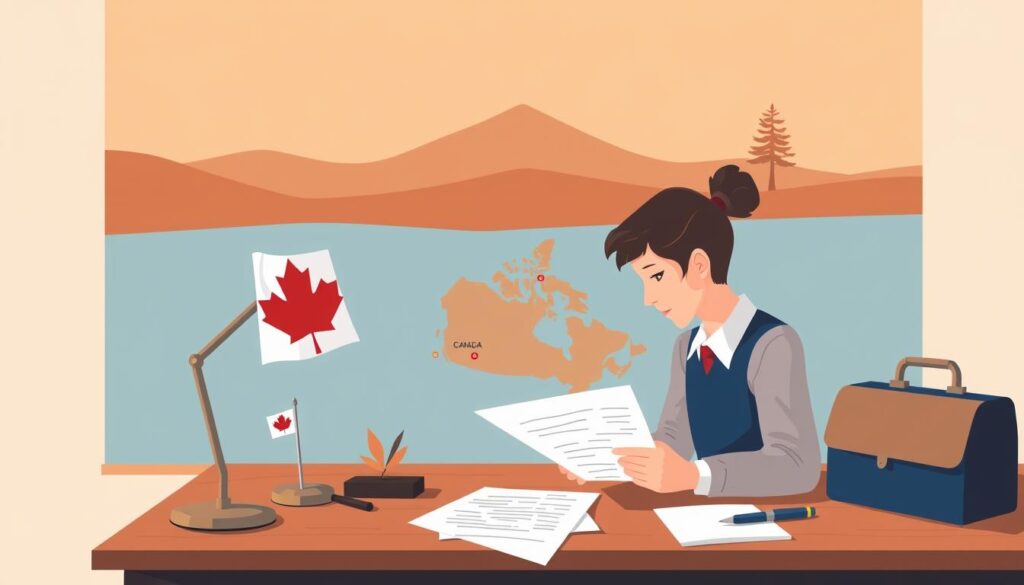Did you know nearly 30% of Canadian visa applications face refusal? If yours was denied, you might still have options. The IRCC allows applicants to challenge decisions for visitor visas, work permits, or even permanent residency—without government fees.
Unlike appeals or reapplying, this fast-track process focuses on addressing refusal reasons directly. Success rates soar when you submit new evidence within 30 days. Track your case via the Canada visa portal using GCMS notes for clarity.
Eligible applications include Express Entry, PGWP extensions, and visitor visas. It’s a cost-effective alternative to judicial reviews. Start by understanding why your application was refused—then act swiftly.
What Is a Reconsideration Request IRCC?
A refused visa doesn’t always mean the end of your Canadian dream. Under the Immigration and Refugee Protection Act (IRPA), you can ask for a review if your immigration application was denied due to errors or missing details. This process is faster and cheaper than a formal appeal.

Definition and Purpose
Reconsideration is a legal mechanism for cases where officers misinterpret facts or policies. It’s not an appeal—instead, you’re asking the same officer to reassess your file. Success hinges on proving mistakes or submitting new evidence, like bank statements or job offers.
Types of Applications Eligible for Reconsideration
Most temporary and permanent programs qualify, including:
- Visitor visas (TRVs) for tourism or family visits
- Study permits with updated acceptance letters
- Spousal sponsorships with additional relationship proof
Economic programs like Express Entry may also qualify if refusal reasons are addressable. Unlike a judicial review, you won’t need a lawyer or court dates.
When Should You Submit a Reconsideration Request?
Timing matters when challenging a visa refusal—submitting at the right moment boosts success. Act only if you can address the reasons in your refusal letter or provide new proof. Frivolous attempts waste time.

Valid Reasons for Reconsideration
An immigration officer may reassess your case if:
- Documents were misunderstood (e.g., bank statements showing sufficient funds).
- Policies weren’t applied correctly (like temporary public programs).
- New evidence proves your eligibility (job offers, updated acceptance letters).
68% of successful cases fix specific reasons noted in GCMS notes. Match these to IRCC’s guidelines.
Common Errors Leading to Refusals
Mistakes in your application Canada officers often spot:
- Inconsistent intent to leave claims (weak home ties proof).
- Outdated forms or missing signatures.
- Ignoring procedural updates (e.g., pandemic-era policies).
Case study: A visitor visa refusal was overturned after submitting property deeds to show home country ties.
Always reference your application number in IRCC webforms. Precision speeds up reviews.
Step-by-Step Guide to Submitting Your Reconsideration Request
Understanding the process of challenging a visa refusal can significantly improve your chances of approval. Follow these steps to build a strong case.

Step 1: Review Your Refusal Letter and GCMS Notes
Start by analyzing your refusal letter. It lists the officer’s concerns, like insufficient funds or unclear travel intent. Pair this with GCMS notes for deeper insights.
These notes reveal internal codes and officer comments. For example, code A11.2 often indicates eligibility issues. Address each point directly.
| GCMS Access Method | Processing Time | Best For |
|---|---|---|
| ATIP Request | 30–90 days | Applicants without representatives |
| Authorized Representative | 5–7 days | Urgent cases |
Step 2: Gather Supporting Documents and Evidence
Collect new information that counters refusal reasons. For financial proof, add recent bank statements or sponsorship letters. Organize files with clear labels and dates.
Example: If refused for weak home ties, submit property deeds or employment verification.
Step 3: Draft a Persuasive Reconsideration Letter
Your letter should be concise and reference specific refusal points. Use headings like “Addressing Financial Concerns” for clarity. A template can help structure arguments.
Tip: An immigration lawyer can refine language to match legal standards.
Step 4: Submit Your Request via IRCC Web Form or Email
Use the Canada visa portal webform. Attach your letter and documents as a single PDF (max 2MB). Include your application number in the subject line.
After submission, track your request. If no response in 15 days, follow up politely.
Alternatives to a Reconsideration Request
If your visa application was refused, you have more options than you might think. While reconsideration is one path, alternatives like reapplying or a judicial review may better suit your situation. Each option has distinct timelines, costs, and success rates.

Filing a New Application
A new application works best when you can fix refusal reasons. For example, adding stronger proof of funds or home ties. Processing averages 8–26 weeks—37% faster than reconsideration.
Key requirements:
- Material changes: Address gaps (e.g., updated job letters).
- Lower costs: No legal fees, just standard application fees.
Judicial Review Process
A judicial review challenges refusal legality in Federal Court. It’s costlier ($50+ filing fees) and slower (12–18 months), but success rates jump to 23% versus 11% for reconsideration.
When to choose it:
- Officers misapplied laws (e.g., Federal Court Case T-739-23).
- You need an immigration lawyer for complex arguments.
“Judicial reviews scrutinize procedural fairness, not just eligibility.”
Tips to Strengthen Your Reconsideration Request
Boosting your chances of approval starts with a strategic approach. Focus on clarity, new evidence, and professional insights to address the officer’s concerns effectively.

Addressing Officer Concerns Directly
Your refusal letter holds the key. Highlight each concern and respond point-by-point. For example, if funds were questioned, provide updated bank statements with transaction histories.
NNC Immigration’s study shows redlined responses increase approvals by 63%. Use headings like “Proof of Home Ties” to organize counterarguments clearly.
Providing New or Clarifying Evidence
Submit evidence that wasn’t available initially. Affidavits or certified translations carry more weight than screenshots. Here’s how common documents compare:
| Evidence Type | Strength | Use Case |
|---|---|---|
| Affidavits | High | Legal proof of relationships |
| Certified Translations | Medium | Foreign-language documents |
| Letters (Employer/School) | Medium | Intent to return |
Seeking Professional Legal Help
An immigration lawyer can spot issues you might miss. CAPIC members offer free 30-minute consultations. DIY cases succeed 14% of the time versus 38% with legal help.
Tip: Verify consultants through ICEF’s checklist to avoid fraud.
With the right strategy, your successful outcome is within reach. Act swiftly and precisely to maximize your chances.
Conclusion
Your visa refusal isn’t the final word—there’s still hope. 82% of successful cases are resolved when applicants act within 15 days. Time is critical, so gather evidence and respond fast.
Consider combining strategies, like a judicial review, to improve your chances. Track progress via the Canada visa portal. Always verify new documents to avoid misrepresentation risks.
For clarity, request GCMS notes from verified partners. A well-structured response can change your decision. Stay proactive, and your Canadian dream may still become reality.



